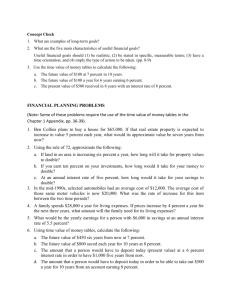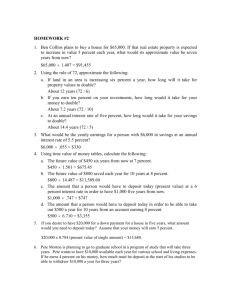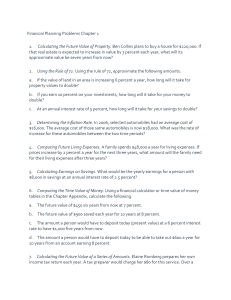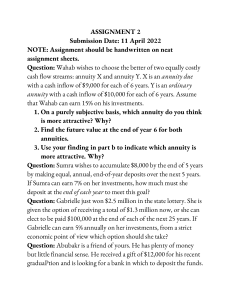Chapter1HomeworkFCS3450Fall2011withanswers
advertisement
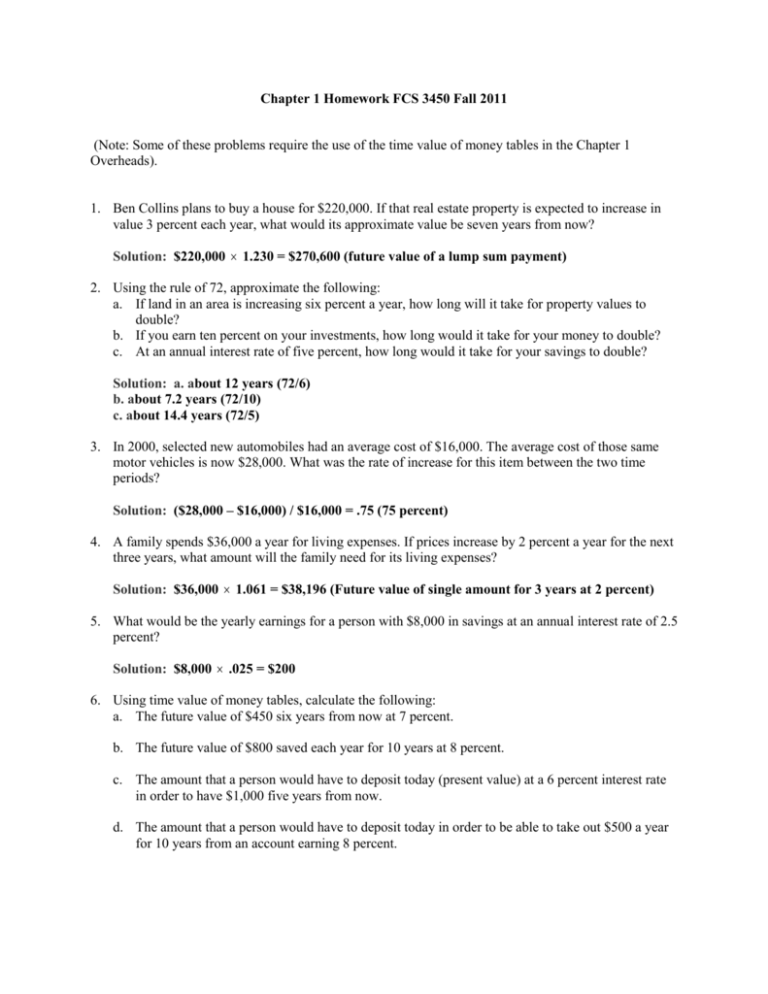
Chapter 1 Homework FCS 3450 Fall 2011 (Note: Some of these problems require the use of the time value of money tables in the Chapter 1 Overheads). 1. Ben Collins plans to buy a house for $220,000. If that real estate property is expected to increase in value 3 percent each year, what would its approximate value be seven years from now? Solution: $220,000 1.230 = $270,600 (future value of a lump sum payment) 2. Using the rule of 72, approximate the following: a. If land in an area is increasing six percent a year, how long will it take for property values to double? b. If you earn ten percent on your investments, how long would it take for your money to double? c. At an annual interest rate of five percent, how long would it take for your savings to double? Solution: a. about 12 years (72/6) b. about 7.2 years (72/10) c. about 14.4 years (72/5) 3. In 2000, selected new automobiles had an average cost of $16,000. The average cost of those same motor vehicles is now $28,000. What was the rate of increase for this item between the two time periods? Solution: ($28,000 – $16,000) / $16,000 = .75 (75 percent) 4. A family spends $36,000 a year for living expenses. If prices increase by 2 percent a year for the next three years, what amount will the family need for its living expenses? Solution: $36,000 1.061 = $38,196 (Future value of single amount for 3 years at 2 percent) 5. What would be the yearly earnings for a person with $8,000 in savings at an annual interest rate of 2.5 percent? Solution: $8,000 .025 = $200 6. Using time value of money tables, calculate the following: a. The future value of $450 six years from now at 7 percent. b. The future value of $800 saved each year for 10 years at 8 percent. c. The amount that a person would have to deposit today (present value) at a 6 percent interest rate in order to have $1,000 five years from now. d. The amount that a person would have to deposit today in order to be able to take out $500 a year for 10 years from an account earning 8 percent. Solution: a. $450 1.501 = $675.45 (future value of a single payment) b. $800 14.487 = $11,589.60 (future value of an annuity) c. $1,000 0.747 = $747 (present value of a single payment) d. $500 6.710 = $3,355 (present value of an annuity) 7. Elaine Romberg prepares her own income tax return each year. A tax preparer would charge her $80 for this service. Over a period of 10 years, how much does Elaine gain from preparing her own tax return (assumes that she earn 3 percent on a savings account)? Solution: $80 11.464 = $917.12 (future value of an annuity). 8. If you desire to have $20,000 for a down payment for a house in five years, what amount would you need to deposit today? Assume that your money will earn 5 percent. Solution: $20,000 x 0.784 (present value of single amount) = $15,680 9. Pete Morton is planning to go to graduate school in a program of study that will take three years. Pete wants to have $12,000 available each year for various school and living expenses. If he earns 4 percent on his money, how much must he deposit at the start of his studies to be able to withdraw $12,000 a year for three years? Solution: $12,000 x 2.775 (present value of an annuity) = $33,300 10. Carla Lopez deposits $3,000 a year into her retirement account. If these funds have an average earning of 9 percent over the 40 years until her retirement, what will be the value of her retirement account? Solution: $3,000 x 337.890 (future value of a series) = $1,013,670 11. If a person spends $15 a week on coffee (assume $750 a year), what would be the future value of that amount over 10 years if the funds were deposited in an account earning 3 percent? Solution: $750 x 11.464 (future value of a series) = $8,598. 12. A financial company that advertises on television will pay you $60,000 now in exchange for annual payments of $10,000 that you are expected to receive for a legal settlement over the next 10 years. If you estimate the time value of money at 10 percent, would you accept this offer? Solution: (1) calculate the future value of the annual payment $10,000 X 15.937 = $159,370 (2) calculate the present value of that future flow: $159,370 X 0.386 = $61,516.82 (3) the $60,000 being offered now is less than the present value of the future flow. 13. Tran Lee plans to set aside $2,400 a year for the next six years, earning 4 percent. What would be the future value of this savings amount? Solution: $2,400 X 6.633 = (future value of a series) = $15,919.20 14. If you borrow $8,000 with a 5 percent interest rate to be repaid in five equal payments at the end of the next five years, what would be the amount of each payment? (Note: Use the present value of an annuity table in the Chapter Appendix.) Solution: $8,000 / 4.329 = $1,848 FINANCIAL PLANNING ACTIVITIES 15. Using Sheet 1-2 Goals in the Personal Financial Planner, create at least three short-term, intermediate-term and long-term goal for yourself.
